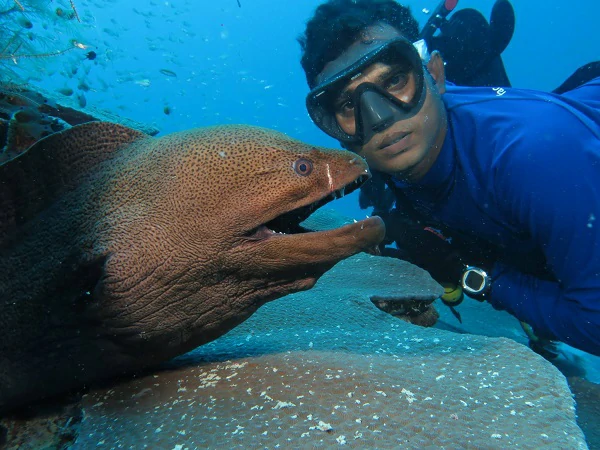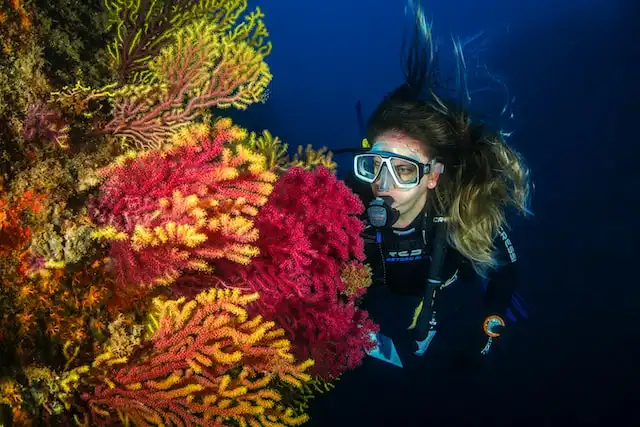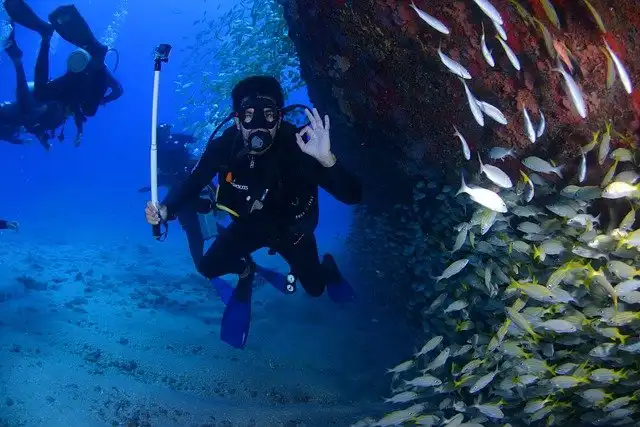
Diver exploring the vibrant coral formations at Maaya Thila, one of the Maldives' most famous dive sites
Discover the underwater paradise of the Maldives, home to some of the world's most spectacular dive sites. With crystal-clear waters, vibrant coral reefs, and an incredible diversity of marine life from tiny nudibranchs to majestic whale sharks, the Maldives offers diving experiences for every skill level. Our comprehensive guide covers the best diving spots across the archipelago, with detailed information on marine life, visibility, currents, and the best time to visit each site.
Video: Explore the underwater wonders of the Maldives' top dive sites
Eastern Atolls: Best visibility (30-40+ meters)
Marine Life Highlights:
Conditions: Calmer seas, less rain, excellent visibility
Best For: Photographers, beginners, all-around diving
Western Atolls: Best visibility (20-30+ meters)
Marine Life Highlights:
Conditions: Occasional rain showers, slightly reduced visibility
Best For: Experienced divers, manta enthusiasts, lower prices
One of the first discovered dive sites in the Maldives, this banana-shaped reef offers spectacular topography:
Best time to dive: Year-round, but best visibility during northeast monsoon (Dec-Apr)
Read Full Dive Site GuideA stunning underwater pinnacle known for its colorful soft corals and strong currents:
Best time to dive: Northeast monsoon (Dec-Apr) for best visibility and manageable currents
Read Full Dive Site GuideAn exhilarating channel dive known for its fast currents and pelagic encounters:
Best time to dive: Incoming tide for best shark sightings, year-round but best visibility Dec-Apr
Read Full Dive Site GuideA perfect beginner-friendly wreck dive combined with a beautiful reef:
Best time to dive: Year-round, good for night diving with many critters
Read Full Dive Site GuideOften rated as one of the world's top dive sites, this underwater pinnacle is a marine life magnet:
Best time to dive: Year-round, but night dives are particularly spectacular
Read Full Dive Site GuideA legendary dive site known for its abundant shark population:
Best time to dive: Year-round, but shark activity peaks during incoming currents
Read Full Dive Site GuideRecommended resorts for beginners: Bandos, Kurumba, Vilamendhoo
Recommended resorts for advanced divers: Kuramathi, Mirihi, Lily Beach
Best for: Serious divers wanting to maximize dive time and variety
Cost range: $200-500 per person per day all-inclusive
Best for: Mixed groups, those wanting luxury, beginners
Cost range: $70-150 per dive plus accommodation costs
Best sites: Hanifaru Bay (Baa Atoll), Manta Point (North Male), Madivaru (Ari Atoll)
Best season: May-November in western atolls, December-April in eastern atolls
Behavior: Visit cleaning stations or feed in plankton-rich waters
Diving tip: Maintain distance and never chase mantas; position yourself where currents bring them to you
Best sites: South Ari Atoll Marine Protected Area, Maamigili, Dhigurah
Best season: Year-round in South Ari Atoll, but peak sightings November-April
Behavior: Often found near the surface in plankton-rich waters
Diving tip: Many whale shark encounters are snorkeling rather than diving experiences
Best sites: Fish Head, Maaya Thila, Rasdhoo Madivaru, Fotteyo Kandu
Best season: Year-round, but stronger currents bring more sharks
Species: Grey reef, white-tip, black-tip, silver-tip sharks
Diving tip: Use reef hooks during channel dives to observe sharks safely in current
While certification is required for most dive sites, beginners can still experience Maldives diving through Discover Scuba Diving (DSD) programs offered at nearly all resorts and dive centers. These supervised introductory experiences allow non-certified divers to experience shallow dives (typically to a maximum of 12 meters/40 feet) after a brief skills session. For the full Maldives diving experience, however, certification is recommended. Many resorts offer PADI Open Water certification courses (3-4 days) that can be completed during your stay, allowing you to dive more sites by the end of your trip.
All dive centers and liveaboards in the Maldives provide complete equipment rental, so you can travel light if preferred. However, many divers choose to bring their own mask, snorkel, and fins for comfort and hygiene. If you're doing multiple dives daily, consider bringing your own dive computer and exposure protection (3mm wetsuit is typically sufficient for Maldives water temperatures). Underwater photographers should bring their own camera gear, including wide-angle lenses for the big marine life encounters. For channel dives, a surface marker buoy (SMB) and reef hook are essential safety items, though these can also be rented. Always bring proof of certification and logbook.
Diving costs vary significantly depending on your approach. Resort-based diving typically costs $70-150 per dive, with discounts for multiple dive packages. Equipment rental adds approximately $30-50 per day for a full set. Liveaboards range from $200-500 per person per day all-inclusive, typically including 3-4 dives daily, making them more cost-effective for avid divers. Certification courses cost around $500-600 for PADI Open Water and $400-500 for Advanced Open Water. Some local islands offer more affordable diving, with prices around $50-70 per dive. Many resorts offer dive packages (10-20 dives) that provide better value than booking individual dives.
Maldives currents can be strong, particularly at channel (kandu) dive sites, but they're manageable with proper training and guidance. These currents are actually what make Maldives diving special, bringing nutrient-rich water that attracts marine life, especially sharks and other pelagics. Dive centers carefully plan dives according to tide tables and current conditions, often choosing to dive during incoming currents when visibility is best and marine life most active. For safety, always dive with reputable operators who provide thorough briefings, follow guide instructions, and stay within your certification and comfort levels. Beginners should start with protected reef dives before attempting channel dives. Advanced divers often use reef hooks at channel sites to observe marine life while remaining stationary in strong currents.
Each Maldives atoll offers unique diving experiences, making "best" subjective based on your interests. Ari Atoll is renowned for consistent pelagic sightings (sharks, mantas, whale sharks) and iconic sites like Fish Head and Maaya Thila. Baa Atoll, a UNESCO Biosphere Reserve, features Hanifaru Bay's manta congregations during southwest monsoon. North and South Male Atolls offer convenient access to diverse sites from the airport, including wrecks, thilas, and channels. For pristine reefs and fewer divers, the southern atolls (Laamu, Huvadhoo, Fuvahmulah) provide exceptional experiences including tiger sharks and hammerheads. Liveaboards typically visit multiple atolls, offering the most comprehensive diving experience, while resort-based divers should choose locations based on their specific marine life interests and the season of their visit.
The Maldives offers some of the world's most spectacular diving experiences, combining pristine reefs, abundant marine life, and excellent visibility in warm, tropical waters. Whether you're a beginner taking your first breaths underwater or an experienced diver seeking adrenaline-pumping channel dives with sharks and mantas, the archipelago's 26 atolls provide dive sites suited to every preference and skill level.
What makes Maldives diving truly special is the combination of healthy coral ecosystems and the opportunity to encounter large pelagic species on the same dive. Few destinations offer such reliable sightings of manta rays, whale sharks, and multiple shark species in such comfortable diving conditions. With year-round diving possibilities and specialized seasonal experiences, the Maldives deserves its reputation as a bucket-list destination for divers from around the world.










